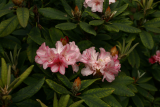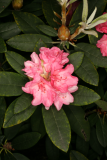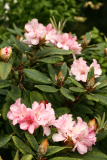Additional notes (click to expand)
Toxicity
Mad Honey is still made and sold today in Turkey and Britain under the local name Deli Bal. The concentration of grayanotoxins is controlled to a low level.
These and similar toxins are probably produced by plants to deter grazing animals and harmful insects, such as thrips.
Mayor, A .1995 Mad Honey!. Archaeology, 4 (6), 32-40
No medicinal value but the leaves of rhododendrons are very poisonous, due to a toxic resin called grayanotoxin. This is also present in the nectar; sucking it from the flowers or eating two leaves, causes serious illness - stomach upsets, gastric haemorrhage, aspiration pneumonia, renal tubular damage and liver damage. Diarrhoea, vomiting, anorexia, weakness, incoordination, stupor and often death (Illinois Veterinary library website, 2013).
Honey from pollen of R. luteum is thought to have poisoned Xenophon's army in 401BC and Pompey's army in his campaign against King Mithridates of Pontus in 66 BC. Honey from another rhododendron, R. afghanicum, poisoned Alexander the Great's army in 327 BC. However this may both have been due to Oleander.
Oakeley, Dr. Henry F. (2013). Wellcome Library notes.
link
Rhododendron species contain poisonous grayanotoxins, cyclic diterpenes that can derange functioning of the brain and sometimes of the heart after consumption of flowers, nectar and leaves by humans and animals.
R ponticum, which grows well in northern Turkey, has a famous history of causing mass poisoning after consumption of ‘Mad Honey’ made by bees feeding on its nectar. It is said to have led to mass casualties, such as the defeat of Pompey’s Roman soldiers by King Mithridatus VI of Pontus in 65BCE and other instances.
Mad Honey is still made and sold today in Turkey and Britain under the local name Deli Bal. The concentration of grayanotoxins is controlled to a low level.
These and similar toxins are probably produced by plants to deter grazing animals and harmful insects, such as thrips.
Islam, M. et al. 2013. Toxic Compounds in Honey. J .Appl. Toxicol., 34, 733-742. Mayor, A .1995 Mad Honey!. Archaeology, 4 (6), 32-40 : https://www.kew.org/read-and-watch/hidden-poison-rhododendron-nectar
"Humans/Pets: Harmful if eaten"- HTA guidelines
HTA Guide to Potentially Harmful Plants, 3rd Edition (2022)
Rhododendron 'Grumpy'
Family: ERICACEAEGenus: Rhododendron
Species:
Cultivar: 'Grumpy'
Distribution summary: Garden origin
Habit: Shrub
Hardiness: H6 - Hardy; very cold winter
Habitat: Moist woodland and riverbanks
Garden status: Not currently grown
Flowering months: May
Reason for growing: Toxic
.JPG)

.JPG)
.JPG)

